How To Cook Tuna Steak: Thermal Principles For the Other Red Meat
If you’ve read this blog for long, you know we have a great love for steaks. Ribeye, NY strip, picanha…tenderloin filet—we love them all. But sometimes, just sometimes, we feel like we could use a break from steak. And that’s why we’re glad there’s such a thing as tuna steak.

If you’ve never had a tuna steak, you don’t know what you’re missing. Seared to form a delicious crust but still rare inside, a steak of quality tuna is not at all fishy but is savory, meaty, with a slight sweet freshness that is incredible. It is the red-meat of the sea. But it is, alas, all too often overcooked. Particularly by home cooks. And when it’s overcooked, it loses much of its charm.
Here, we’ll discuss the thermal principles behind a seared tuna steak so that you can make it properly for yourself. With a Thermapen® on hand, you really can recreate this high-end restaurant entree with the greatest of ease and confidence.
What happens when you cook a tuna steak
Tuna is far more than the cheap canned meat you buy for sandwiches. In fact, it is among the most beloved and sought after fish in the world, with a rich history dating back to the Roman empire. The belly of the tuna, called toro, is super fatty (read: delicious) and can fetch prices of up to hundreds of dollars per pound. Now, you won’t be seeing that kind of tuna sold as a steak, generally. Usually what you’ll find is ahi (also called yellowfin) tuna loins offered as steak. If you can find or afford bluefin, though, go for it!
To understand how a tuna steak works, we need to look at the fish itself. Tuna is a large oceangoing predatory fish that can grow up to 1,500 lbs. They are speedy swimmers, reaching steady speeds of up to 40 mph. All that fast swimming takes some serious muscle, and even the muscles that, in other fish, are bland and pale are deeply imbued with oxygen-storing hemoglobin and loads of energy-creating enzymes.
The meaty color of certain tunas is caused by the oxygen-storing pigment myoglobin, which these fish need for their non-stop, high-velocity life. Fish myoglobin is especially prone to being oxidized to brownish metmyoglobin, [even] at freezer temperatures down to -22°F/-30°C; tuna must be kept frozen well below this to keep its color. During cooking, fish myoglobins denature and turn gray-brown at around the same temperature as beef myoglobin, between 140 and 160°F/60 and 70°C.
Harold McGee, On Food and Cooking, pg 194
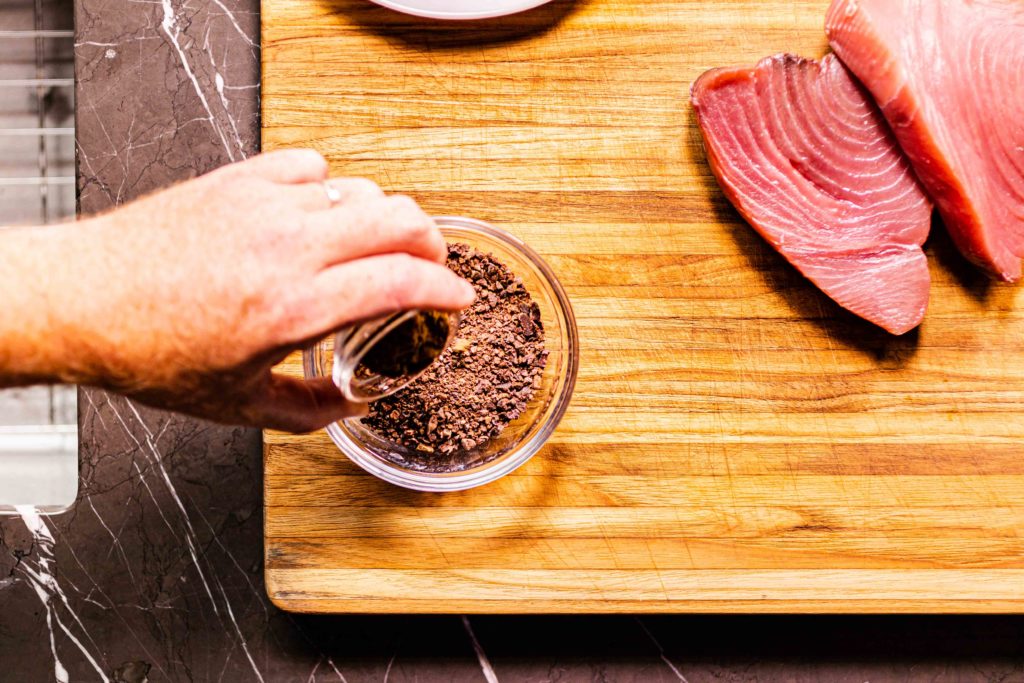
Like all fish, however, the connective tissues in tuna are much easier to break down by cooking than those of beef. That means it is much easier to cook a tuna steak into a dry, crumbly mess than beef. And in fact, if you overcook it, it transforms from a delicious steak into something almost indistinguishable from canned tuna, with an overly sharp, almost metallic flavor. (More on not overcooking tuna below!)
Should I use Sushi-grade tuna?
When you shop for tuna steaks, you will certainly be faced with people telling you that this-or-that tuna is sushi grade. In truth, that is hogwash. “Sushi-grade” is a term invented by clever marketers and has no meaning. It signifies nothing of importance in the real world. All that it indicates is that the seller thinks it will be both fresh and tasty enough to be eaten raw (or rare). That doesn’t mean all tuna is going to be good for steaks or sushi. Shop from a reputable, knowledgeable, quality supplier of fish and there’s a good chance all their tuna will be good enough to eat raw or rare, even without a fancy marketing term attached to it.
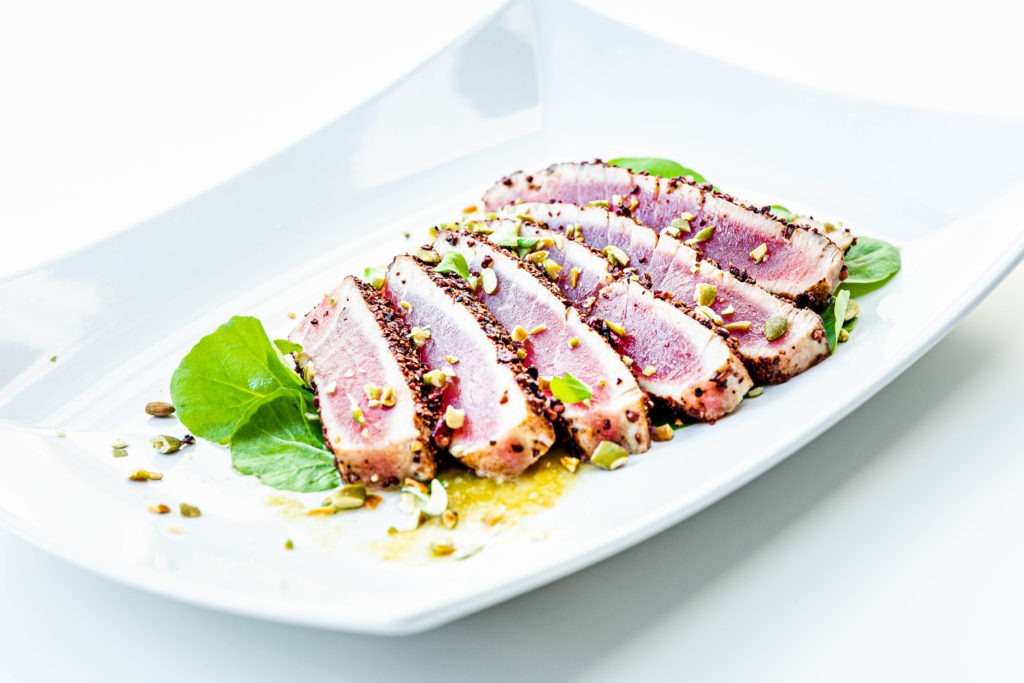
Tuna steak temperatures
To get the most out of a tuna steak, you need to be very careful with temperature. Not only is it ruined by overcooking, but it needs careful temperature control along the way.
Keeping it cool
Most fish that are to be eaten raw must, according to the FDA’s guidelines, be deeply frozen for a certain period before being consumed. Tuna, however, need not.
Exempted from the FDA’s freezing requirements are…large species of tuna—deemed safe based on the frequency with which they are eaten in raw form and the infrequency of related, documented parasitic infection.
SeriousEats.com, What Is “Sushi-Grade,” Anyway? A Guide to Eating Raw Fish at Home
Tuna has proven itself safe to eat raw or rare, which is great news! But just because it can be eaten without deep freezing doesn’t mean it doesn’t need temperature monitoring. One of the risks posed by tuna is scombroid poisoning.
Scombroid poisoning is unusual in that it is caused by a number of otherwise harmless microbes when they grow on insufficiently chilled mackerels of the genus Scomber and other similarly active swimmers, including tuna… Within half an hour after eating one of these contaminated fish, even fully cooked, the victim suffers from temporary headache, rash, itching, nausea, and diarrhea. The symptoms are apparently caused by a number of toxins including histamine.
Harold McGee, On Food and Cooking, pg 185
This isn’t meant to scare you off, of course. It’s meant to convince you to keep your tuna in the fridge until it’s time to cook it. Dangerous histamine and toxin levels can be reached in 6 hours of improper refrigeration. When I go to buy tuna, I always take a cooler with ice in the car with me, just to make sure I don’t add to any time to the time the fish may have already spent out of refrigeration during processing or transport.
Cooking it up
Because you don’t want it to overcook, you need your tuna steak to have some significant thermal mass, and that means buying steaks that are at least an inch thick. As noted above, keeping your fish chilled until the last moment is an important safety step, but beyond that, it’s also thermally advantageous. Cold tuna presents a greater barrier to heat transfer than does warm tuna, making overcooking less likely.
To get a quality sear, you need high heat. A cast-iron or other heavy-bottomed pan will provide enough heat capacity to sear a tuna steak, and a light skiff of high smoke-point oil on the surface will enhance heat transfer from the pan to the fish while also preventing sticking. The pan is heated over high heat and the fish is only added once the surface is hot: 425–450°F (218–232°C).

I like my tuna quite rare, so it only needs a minute or so of cooking per side, but the real tell is the internal temperature. We have found that when searing at that high temperature, the internal temp of a tuna steak can increase by as much as 25°F (14°C) after being removed from the heat! A final temp of about 90°F (32°C) makes for a beautifully rare steak that is still red and has the luxurious texture that is a hallmark of a good tuna steak. That means pulling your tuna from the pan at a mere 65°F (18°C)—as read on a fast instant-read thermometer like the Thermapen®.
Once you flip your tuna onto its second side, start taking its temperature immediately to watch for the pull temperature. Even a few degrees of overcooking can make a huge difference in the final taste and texture of your fish.
When we cooked our steak, we wanted to see how much carryover cooking there was. To that end, we used a BlueDOT™ thermometer and the free ThermoWorks app to track the temperature when we took the steak off the heat. We inserted a short probe into the tuna and recorded the data. You can see how much carryover there was!
On seasoning tuna
Tuna steaks are most often associated with the Japanese flavor palate. They can be crusted in sesame and served with miso or wasabi sauces, but that needn’t necessarily be the case. Pick a seasoning you like and use it—salt and pepper are fine! In this version, we’re actually going with a more Mexican flavor, coating the steak in cacao nibs, cinnamon, and black pepper. Just make sure that whatever you use doesn’t overpower the flavor of the steak itself!
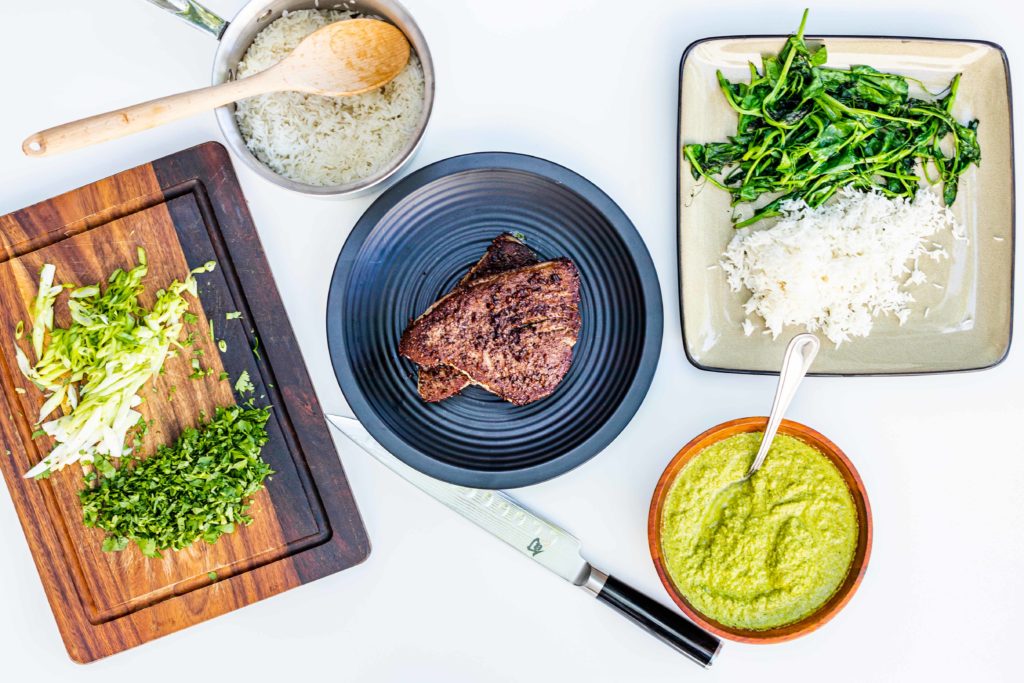
Seared Tuna Steak Recipe
Ingredients
- 2 good-quality tuna steaks, at least 1 1/2″ thick
- 1/2 C cacao nibs
- 1/2 tsp ground black pepper
- 1/4 tsp ground cinnamon
- salt
- 3 Tbsp neutral, high-heat oil, such as peanut or corn oil

For the mole verde sauce
- 3 large tomatillos, quartered
- 1 bunch cilantro
- 1 bunch scallions
- the juice of 1 lime
- 1 clove garlic
- 1 jalapeño pepper
- 4 Tbsp toasted, shelled pumpkin seeds
- salt to taste
Instructions
For the sauce
- Combine all the ingredients except the salt in a blender and blend until the mixture is nearly smooth.
- Pour the mixture into a small saucepan and bring it to a simmer. Simmer until it thickens, and add salt to taste.
Prepare and sear the tuna
- Combine the cacao nibs, cinnamon, and pepper in a spice or coffee grinder and pulse until the nibs are the coarseness of bulgur.
- Rub each tuna steak all over with a half tablespoon of oil each.
- Salt each of the steaks fairly liberally on both sides.
- Pour the cacao mixture onto a small plate and dredge each side of the tuna in the mixture, pressing down on it make it adhere better.

- Place up to one tablespoon of oil in the pan and preheat it over high heat.
- When the pan is hot, with a few bare wisps of smoke coming off the oil, place one of the tuna steaks in the pan, pressing down slightly to ensure good contact.
- Cook for a little over one minute, then flip the steak.

- As soon as you flip the steak, start measuring its temperature with a Thermapen. Once the temperature reaches 65°F (18°C), pull it from the heat and set it aside.
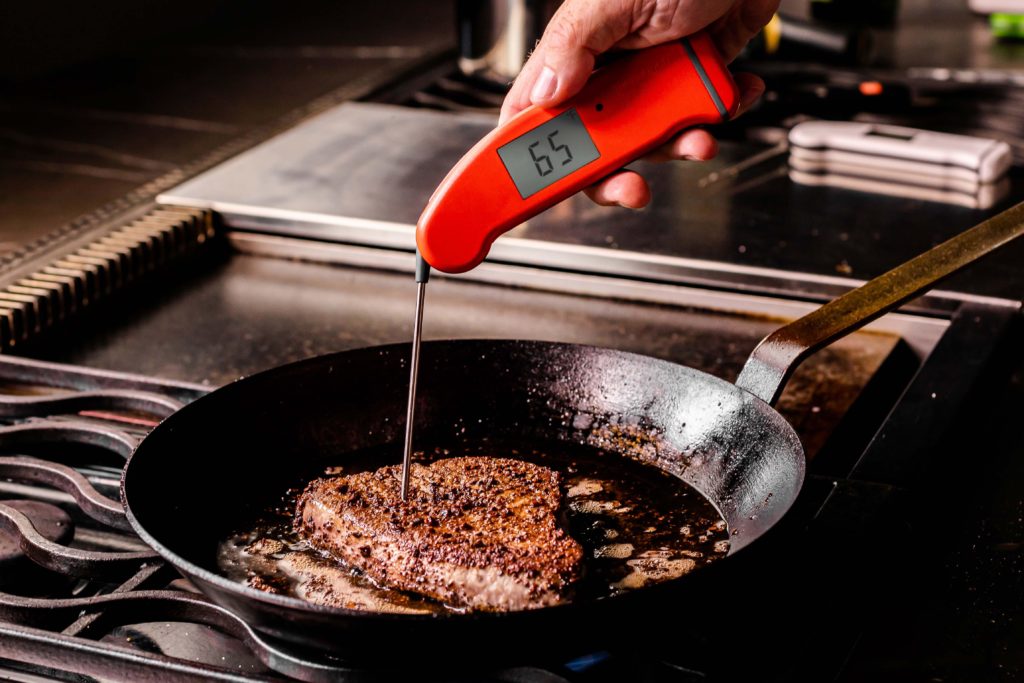
- Wipe out the pan and repeat with the second steak.
- Serve with the sauce, some rice, and some greens.
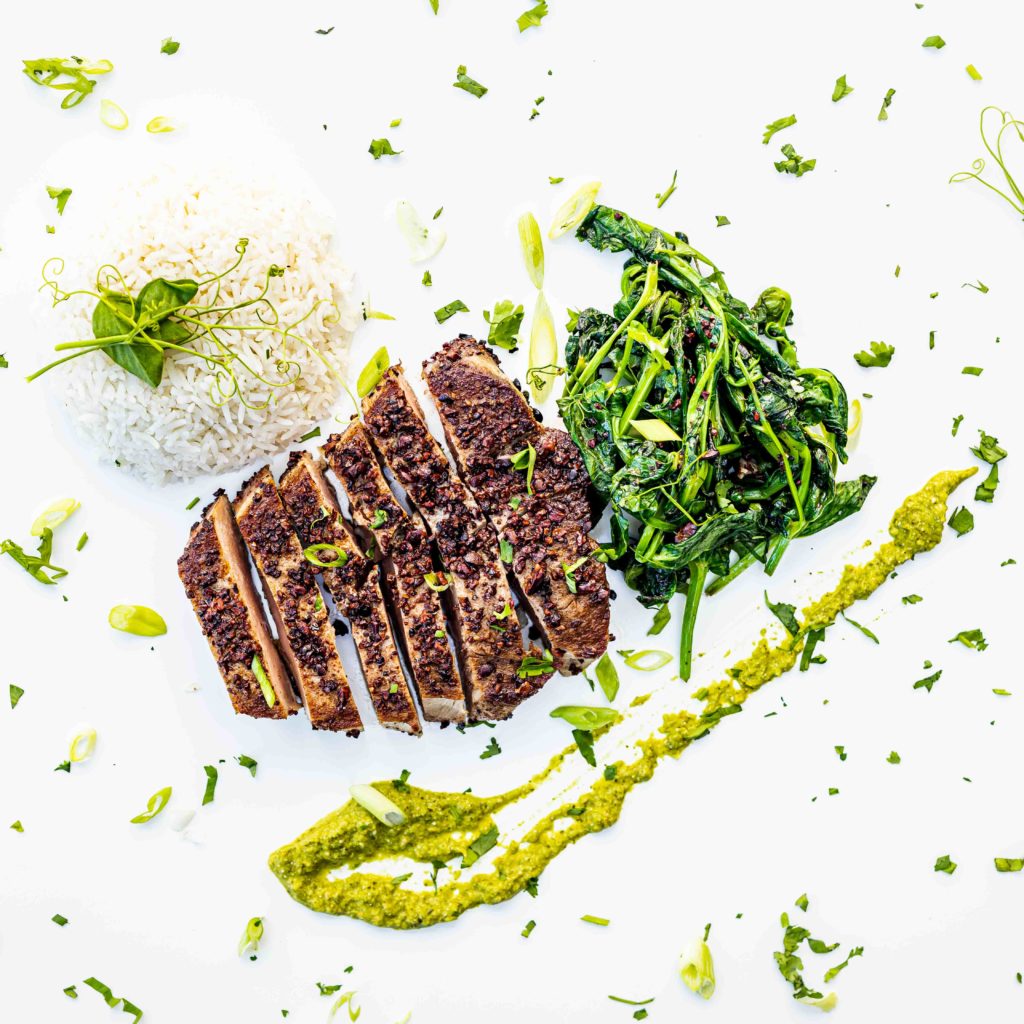
A tuna steak, properly made, is a culinary treasure. Cooking it at home gives you the advantages of controlling flavor and saving money. As long as you watch the temperature with your Thermapen®, you can get perfect, meaty tuna steaks in your own kitchen, and enjoy the other red meat on your own terms.
Shop now for products used in this post:


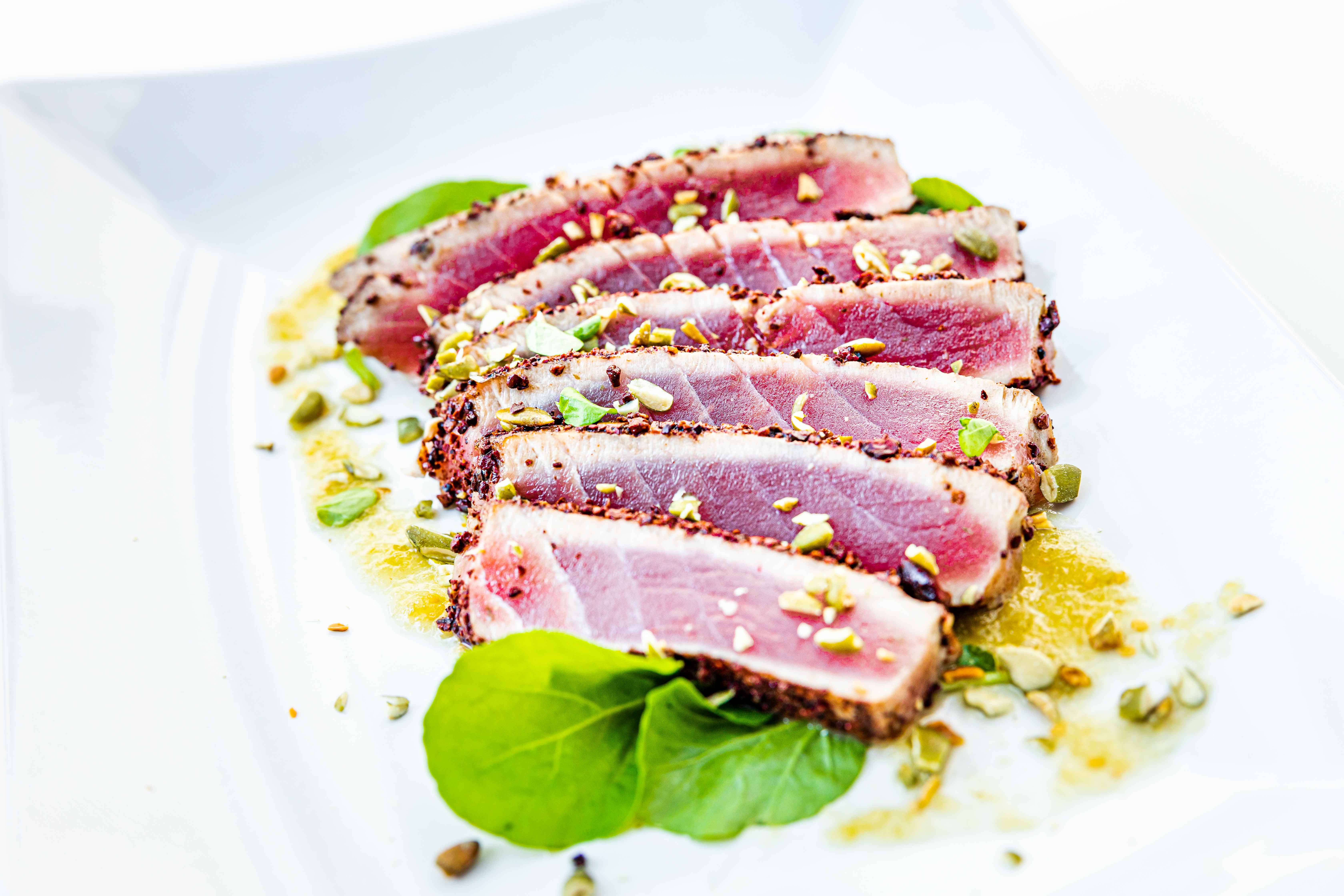

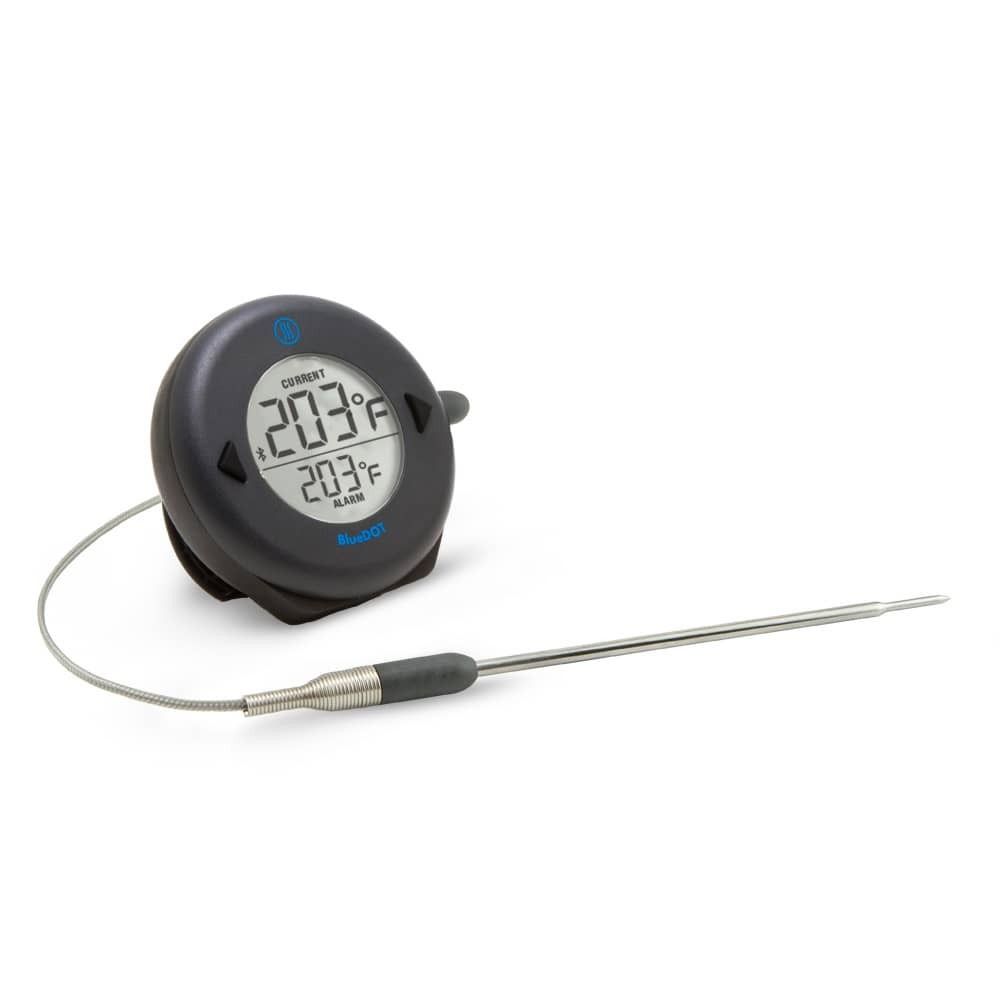
Very informative article, thanks. May I assume the same instructions apply to grilling tuna steaks, ie remove from heat @65F? I have seen some articles that suggest near-freezing before grilling, do you think this necessary if grilling? We enjoy most all fish and shellfish on the grill so any tips on how to manage will be appreciated.
Michael,
Near freezing before grilling is a pretty good idea, especially if you want lots of grilled flavor. Two-3 minutes of total grilling time won’t get you a lot of grilled flavor, but by nearly freezing the tuna, you can leave it on the heat a bit longer. Good idea!
You could also cold smoke the tuna, let it sit for a bit in the fridge and than grill it. It’ll have way more flavor that way from the grill.
I have 2 beautiful Ahi steaks. About 1 1/4 tick thick. While I love it rare, as it should be, I’m on medication that requires all my meat fully cooked. Mid-week at the least. Should I soak or marinade to get it well done without it being dry? What is your opinion on how to cook this? We are going blackened.
Tiffany,
That is a tough question. I’d probably dry brine them. Dry brining helps to neutralize some of the proteins that will dry out in cooking, so that will help some. But fully cooking it will have other enzymatic and protein effects that are unavoidable.
Something you might consider is to change your method completely. Maybe seasoning them overnight and then poaching them gently in olive oil with a few crushed cloves of garlic and then using them to make an amazing salad Nicoise would be better than going for the steak. That would be delicious!
We get fresh Ahi from Costco that`s good,my trick for a good sear and very rare center is to leave it in the fridge just prior to cooking.Try to pick the thickest piece you can get,works for me.
Finally somewhere that says something can rise for more than 10 degrees. I’ve been finding 20 degree raised on burgers. And 30 degree raises on roast beef.
However I’m surprised by the final temp of 90. Another link “best temps for seafood” on thermoworks, recommends 115. I’ve also seen 120 recommended.
Kane,
We were surprised by the carryover, too! Our “Best Temps” post actually says below 115°F. We found it difficult to get a good doneness at 105°F—it was too cooked around the edges—but 90°F was great.
You should make this post like into a definitive guide or something. I bet a lot of your new readers that come to this site would want to be able to find this post. It’s too good to keep secret!
Brian,
Interesting idea! I’ll see what we can do.
When you pull it from the heat should you leave it rest in the pan or transfer to a plate right away till carry over temperature is reached?
Move it to a plate to carryover or it will overcook.
Will Albacore Tuna work with this recipe? It is more readily available in my area.
If you can get it in raw, steak form, it sure will!
I don’t get this “carry over” stuff. When you pull something off the heat, stop supplying it with energy, it should begin to cool immediately, not continue to get warmer. I can’t think of any physics that would allow that. Can you explain it?
Delighted to!
While we are no longer supplying the mass with energy, the heat energy that is in the mass is unevenly distributed. There is a higher concentration of heat closer to the surface than there is in the center. When we remove the external heat, we stop adding more to the surface, but the heat likes to settle to equilibrium. Some of the surface heat will vent to the atmosphere, but most of the temperature gradient will equalize within the food-mass itself.
Think of a tree cross section, with each ring representing a different temperature A temperature ring that is 2 inched into the tree will heat the next ring down. (You could also say that the next ring down cools the next ring up, which is equally true, but bends the brain a little bit more.) That ring is, meanwhile, heating the ring below it. It’s like a fireman’s brigade of heat being handed down the rings to the center until all the rings are at the same temperature.
So carryover cooking doesn’t happen because of external heat (obviously, we took that heat away), but because there is enough heat inside the meat to warm and cook other parts of the meat.
I hope that helps!
Hi, I found your article very insightful, especially all the scientific information and proper citations. I wanted to ask one thing. I recently tried to experiment as well with cooking tuna, and I was trying to obtain a similar result, but using just water instead of oil, basically trading off taste in order to obtain an “almost pure” protein source.
I let half an inch of water boil on a pan and then I place the 1 inch thick tuna steak and close everything with a lid. After little more than a minute I flip it and repeat for little less than the previous timing. Then I let it sit for a couple minutes off the heat. The result I obtain is still a rare steak, with slightly thicker “cooked walls” than the one presented in the article (and softer instead of seared) and the raw inside has a fridge like temperature, so of course it is generally cooler. In this scenario I am very satisfied by the results, as I am not looking for the most tasteful recipe (even if afterwards I sprinkle soy sauce and a thin line of sesame seed oil). I was just wondering if you are aware if there are any type of intrinsic risks of using this procedure instead of the one you propose, I am mostly thinking about the lower internal temperature (maybe higher chance for bacteria/parasites to grow? even if it sounds counterintuitive to me), or if the two procedures can be considered risk-equivalent (provided the use of the same ingredients and freezing temperatures)
Thank you
As far as risk goes, your method should be as safe as mine.